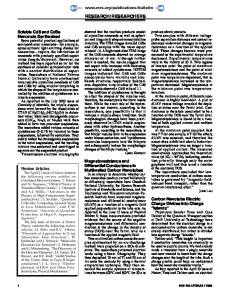Synthesis of Multiwalled Carbon Nanotubes
- PDF / 2,658,177 Bytes
- 6 Pages / 414 x 635.4 pts Page_size
- 17 Downloads / 418 Views
Chemical and Materials Engineering 177 Anderson Hall, University of Kentucky, Lexington, KY 40506
ABSTRACT In a recent publication we have described the synthesis of multiwalled carbon nanotubes (MWNTs) by the reaction of a hydrocarbon vapor over a dispersed iron catalyst that is deposited in situ on quartz substrates'. Our system configuration involves entraining a mixture of xylene and ferrocene into an inert gas stream. Decomposition of the ferrocene at temperatures in the range 625-775 'C, and at atmospheric pressure, produces a coating of iron nanoparticles on the quartz surfaces, and these metal sites function as catalysts for the formation and growth of MWNTs. In this study, we report the influence of operating conditions on MWNT purity and yield. These parameters include the feed injection temperature, furnace temperature, hydrocarbon partial pressure, reaction time, space velocity, and iron to carbon ratio in the feed. We observed that the quality of the MWNTs depend sensitively on the growth parameters and a window for the operating conditions is identified for the growth of high purity aligned MWNTs. Characterization of the MWNTs by electron microscopy has shown that there is a relationship between metal particle size and MWNT diameter. INTRODUCTION The field of carbon nanotubes has been a very active area of research since their discovery in 19912. Several established methods exist to synthesize single walled (SWNTs) 3 -7 and multiwalled carbon nanotubes (MWNTs)8' 9. Recently, we have demonstrated that high purity MWNTs can be produced in bulk quantities on quartz substrates from a catalytic decomposition of a ferrocenexylene mixture at 700 'C' . The Fe:C composition (0.75 at. %) was similar to the transition metal to carbon atomic percentages used in the pulsed laser vaporization 4 or the electric arc methods 5 . The low temperature synthesis process' is an attractive synthesis route since (i) selectivity of the intermediate products can be controlled to generate high purity MWNTs; and (ii) the process is readily scaleable for large scale production of carbon nanotubes. Furthermore, in the synthesis method previously described', the high purity MWNTs self-organize into aligned arrays on quartz substrates that are useful for fundamental studies of the anisotropic properties of carbon nanotubes. Because of their large aspect ratios, the motion of the electrons along the axis of the nanotubes is quasi continuous whereas its motion in the circumferential direction is quantized. In a recent polarized Raman study, Rao et al.1" have shown that the intensity of the graphite-like band around 1600 cm-' exhibit a strong dependence on the polarization geometry employed in the experiments. 15
Mat. Res. Soc. Symp. Proc. Vol. 593 © 2000 Materials Research Society
Mess flow
Pressure relief ,
Prehemter
Furnace
controller
Ferrocene +X~ene
Exhaust Temperature controller
Temperature controller
Gas mixture
Figure 1. Schematic of Reactor System.
EXPERIMENTAL Figure 1 shows schematically the quartz tube reactor
Data Loading...











